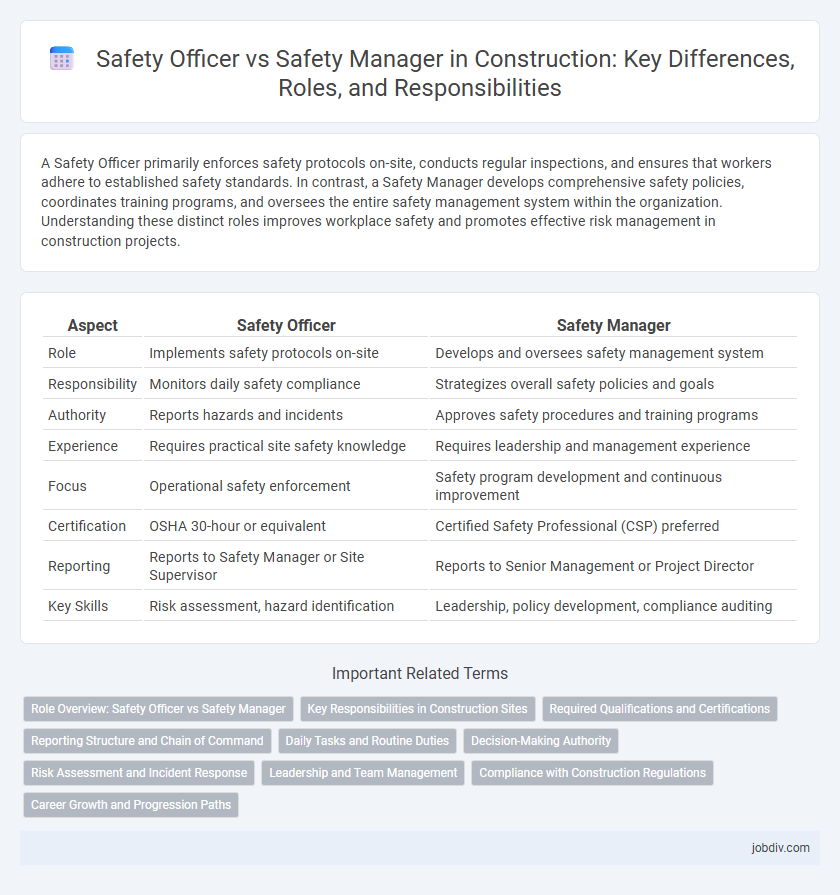A Safety Officer primarily enforces safety protocols on-site, conducts regular inspections, and ensures that workers adhere to established safety standards. In contrast, a Safety Manager develops comprehensive safety policies, coordinates training programs, and oversees the entire safety management system within the organization. Understanding these distinct roles improves workplace safety and promotes effective risk management in construction projects.
Table of Comparison
| Aspect | Safety Officer | Safety Manager |
|---|---|---|
| Role | Implements safety protocols on-site | Develops and oversees safety management system |
| Responsibility | Monitors daily safety compliance | Strategizes overall safety policies and goals |
| Authority | Reports hazards and incidents | Approves safety procedures and training programs |
| Experience | Requires practical site safety knowledge | Requires leadership and management experience |
| Focus | Operational safety enforcement | Safety program development and continuous improvement |
| Certification | OSHA 30-hour or equivalent | Certified Safety Professional (CSP) preferred |
| Reporting | Reports to Safety Manager or Site Supervisor | Reports to Senior Management or Project Director |
| Key Skills | Risk assessment, hazard identification | Leadership, policy development, compliance auditing |
Role Overview: Safety Officer vs Safety Manager
A Safety Officer primarily enforces workplace safety policies, conducts regular inspections, and ensures compliance with health and safety regulations on construction sites. The Safety Manager develops comprehensive safety programs, oversees risk assessments, and leads strategic initiatives to minimize accidents and occupational hazards. Both roles collaborate to maintain a safe work environment, but the Safety Manager holds greater responsibility for policy formulation and overall safety management.
Key Responsibilities in Construction Sites
A Safety Officer on construction sites primarily enforces workplace safety protocols, conducts regular site inspections, and reports hazards to ensure compliance with regulatory standards such as OSHA. In contrast, a Safety Manager develops comprehensive safety plans, oversees implementation of risk management strategies, and leads training programs to promote a culture of safety across multiple projects. Both roles are critical, but the Safety Manager carries broader strategic responsibilities while the Safety Officer focuses on operational enforcement and daily safety monitoring.
Required Qualifications and Certifications
Safety Officers in construction typically require certifications such as OSHA 30-hour training and First Aid/CPR, with a high school diploma or equivalent as the minimum education level. Safety Managers must possess advanced qualifications including a Bachelor's degree in Occupational Health and Safety or Engineering, along with certifications like Certified Safety Professional (CSP) or Construction Health and Safety Technician (CHST). Both roles demand strong knowledge of safety regulations and risk management, but Safety Managers are expected to have more comprehensive training and leadership skills to oversee full safety programs.
Reporting Structure and Chain of Command
Safety officers report directly to the safety manager, ensuring clear communication of site-specific hazards and daily compliance activities within the chain of command. Safety managers oversee multiple safety officers and coordinate broader safety policies, reporting to senior management or project directors for strategic decision-making. The structured reporting hierarchy enhances accountability and streamlines the implementation of occupational health and safety regulations on construction sites.
Daily Tasks and Routine Duties
Safety Officers conduct site inspections, monitor compliance with safety protocols, and report hazards daily to ensure a secure construction environment. Safety Managers develop comprehensive safety plans, oversee training programs, and analyze incident reports to implement preventive measures. While Safety Officers focus on hands-on site supervision, Safety Managers handle administrative responsibilities and strategic safety management.
Decision-Making Authority
A Safety Manager typically holds higher decision-making authority than a Safety Officer, overseeing comprehensive safety policies and ensuring compliance across construction projects. Safety Officers execute these policies on-site, addressing immediate hazards and reporting risks to the Safety Manager for strategic decisions. Effective construction safety relies on the Safety Manager's role in policy development and risk mitigation, while the Safety Officer ensures operational enforcement and real-time safety compliance.
Risk Assessment and Incident Response
Safety Officers conduct detailed risk assessments to identify potential hazards on construction sites, ensuring compliance with safety protocols and regulations. Safety Managers oversee the entire risk management process, integrating assessment results into broader incident response strategies and safety programs. Both roles collaborate to promptly address incidents, minimizing injury risks and maintaining a safe work environment.
Leadership and Team Management
Safety Managers oversee overall site safety programs, establishing policies and coordinating multiple Safety Officers to ensure compliance with regulatory standards. Safety Officers implement daily safety practices, directly supervising crews to enforce protocols and conduct on-site hazard assessments. Effective leadership by Safety Managers fosters a culture of safety through training and strategic planning, while Safety Officers excel in frontline team management and immediate risk mitigation.
Compliance with Construction Regulations
Safety Officers ensure on-site adherence to construction regulations by conducting regular inspections and enforcing safety protocols, directly reducing accident risks. Safety Managers develop and implement comprehensive compliance strategies, coordinate training programs, and liaise with regulatory bodies to maintain up-to-date knowledge of legal requirements. Both roles are critical for meeting OSHA standards and preventing violations that could result in fines or project delays.
Career Growth and Progression Paths
Safety Officers in construction typically focus on implementing on-site safety protocols and conducting regular inspections, serving as the foundation for safety career development. Advancing to a Safety Manager role involves taking on strategic responsibilities, such as developing comprehensive safety programs, managing teams, and ensuring regulatory compliance across multiple projects. Career progression from Safety Officer to Safety Manager often requires additional certifications like OSHA or NEBOSH and gaining experience in leadership and risk management.
Safety Officer vs Safety Manager Infographic

 jobdiv.com
jobdiv.com